On the day he was born—December 11, 1879—outside Crafton in Wise County the wind whistled through the logs of the unchinked one-room cabin of parents William and Josie Carter. By age seven he was picking his weight in cotton each day on their hardscrabble farm. He dropped out of school at age eleven, and after his mother died in childbirth in 1892 he moved to Nocona in adjacent Montague County to live with his grandmother. There he worked in a boardinghouse. More importantly, he collected discarded liquor bottles around town and sold them back to local saloonkeepers. It was the first sales job of a master salesman, a man who would one day sell Texas in general and Fort Worth in particular—and, by extension, himself—to all of America.
Amon Giles Carter soon graduated from Nocona to Bowie, with two thousand souls the metropolis of Montague County. In Bowie he continued to sell: sandwiches to passengers on the Fort Worth & Denver City trains that passed through town. If he could not buy chickens at a good price, he raided henhouses at night. If that failed, he substituted rabbit meat.
Next stop was Norman, Oklahoma. According to Jerry Flemmons in Amon: The Life of Amon Carter, Sr. of Texas, in Norman, Carter met a representative of American Copying Company of Chicago. Carter was hired as a traveling salesman, selling oil portraits.
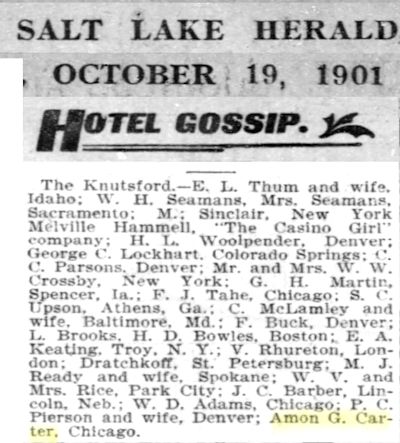 He did so well that by 1901 he was the company’s sales manager in Chicago.
He did so well that by 1901 he was the company’s sales manager in Chicago.
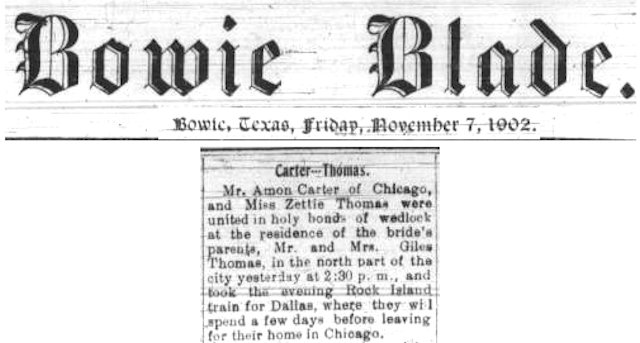 In 1902 Carter returned to Bowie long enough to marry Zettie Thomas, daughter of a prominent local businessman.
In 1902 Carter returned to Bowie long enough to marry Zettie Thomas, daughter of a prominent local businessman.
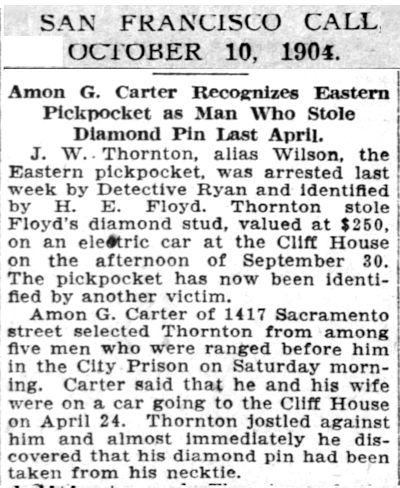 Carter soon made the logical move from selling to advertising, taking a job with an ad agency in San Francisco.
Carter soon made the logical move from selling to advertising, taking a job with an ad agency in San Francisco.
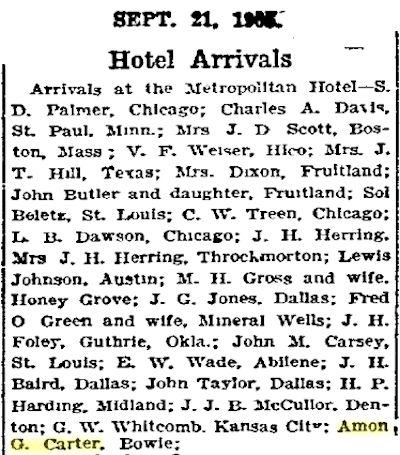 In September 1905 Carter visited Fort Worth, staying at the Metropolitan Hotel. His job in San Francisco was not earning enough to finance his lifestyle, which Flemmons describes as “grandly baroque.” Carter and wife Zettie had a daughter now.
In September 1905 Carter visited Fort Worth, staying at the Metropolitan Hotel. His job in San Francisco was not earning enough to finance his lifestyle, which Flemmons describes as “grandly baroque.” Carter and wife Zettie had a daughter now.
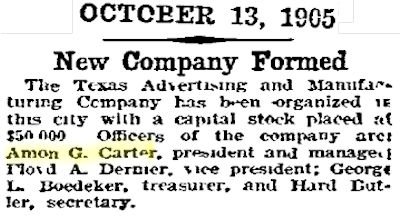 A month later Carter established his own company, Texas Advertising and Manufacturing Company, in Fort Worth. He was president and manager. The company sold an indexing telephone directory and had a concession for streetcar advertising cards.
A month later Carter established his own company, Texas Advertising and Manufacturing Company, in Fort Worth. He was president and manager. The company sold an indexing telephone directory and had a concession for streetcar advertising cards.
To that point, Fort Worth could attribute its growth to three factors in its history: the cattle drives, the railroads, and the stockyards and packing plants. Now came a fourth: Amon Giles Carter.
Soon Carter overheard two local journalists discussing a plan to start a newspaper to compete with Fort Worth’s Telegram. Carter had no money to invest in the newspaper, but he knew someone who did: Paul Waples of the Waples-Platter canning company. Carter talked Waples into investing in the venture. As the major money man, Waples became president of the newspaper company. Carter became advertising manager of the new newspaper, to be named the Star. Waples brought in Louis J. Wortham of Austin to be publisher and editor.
The Star published its first edition on February 1, 1906 in a small office at East 6th and Rusk streets.
But despite Carter’s flair for selling ads, the Star soon was losing money. All the local advertising went to the rival Telegram, leaving the Star with national ads for patent medicines. Bankruptcy loomed. Then Carter came up with an audacious plan: Rather than fold, up the ante. Carter the salesman sold Waples the investor on investing still more money. Ditto merchant W. C. Stripling, who had known Carter in Bowie. Carter pawned a three-carat diamond ring and threw his money into the kitty.
And they bought the Telegram.
 On New Year’s Eve 1908 the final Telegram was published.
On New Year’s Eve 1908 the final Telegram was published.
 On New Year’s Day 1909 the first edition of the Star and Telegram was published. The Telegram got second billing in terms of both placement and font size.
On New Year’s Day 1909 the first edition of the Star and Telegram was published. The Telegram got second billing in terms of both placement and font size.
 One month later, on February 1 1909, the and was replaced by a hyphen, and the Star-Telegram was born.
One month later, on February 1 1909, the and was replaced by a hyphen, and the Star-Telegram was born.
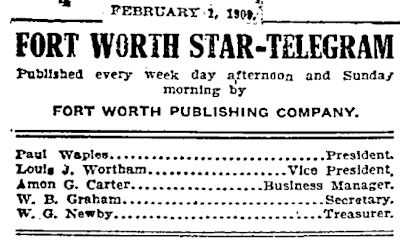 The new newspaper was housed in the Telegram building at West 8th and Throckmorton streets. Amon Carter was now thirty years old. As an investor and the Star-Telegram’s business manager, he had a considerable say in the operation of the Star-Telegram.
The new newspaper was housed in the Telegram building at West 8th and Throckmorton streets. Amon Carter was now thirty years old. As an investor and the Star-Telegram’s business manager, he had a considerable say in the operation of the Star-Telegram.
 Carter’s daughter Ruth, Flemmons writes, would later recall her father as “king of the doodads.” When the newfangled automobile came along, to Amon it was just a big doodad. In 1909 the Star-Telegram sponsored a two-day automobile endurance race from Fort Worth to Waco and back. Also that year the Star-Telegram began publishing a weekly page devoted to automobile news.
Carter’s daughter Ruth, Flemmons writes, would later recall her father as “king of the doodads.” When the newfangled automobile came along, to Amon it was just a big doodad. In 1909 the Star-Telegram sponsored a two-day automobile endurance race from Fort Worth to Waco and back. Also that year the Star-Telegram began publishing a weekly page devoted to automobile news.
 The next doodad Carter took a shine to was the newfangled airplane. In 1911 he helped bring to town Fort Worth’s first air show. At that show Frenchman Roland Garros made the first powered flight from Fort Worth.
The next doodad Carter took a shine to was the newfangled airplane. In 1911 he helped bring to town Fort Worth’s first air show. At that show Frenchman Roland Garros made the first powered flight from Fort Worth.
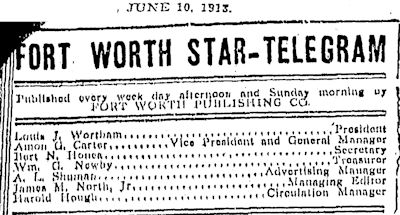
By 1912 Carter was vice president and general manager of the Star-Telegram.
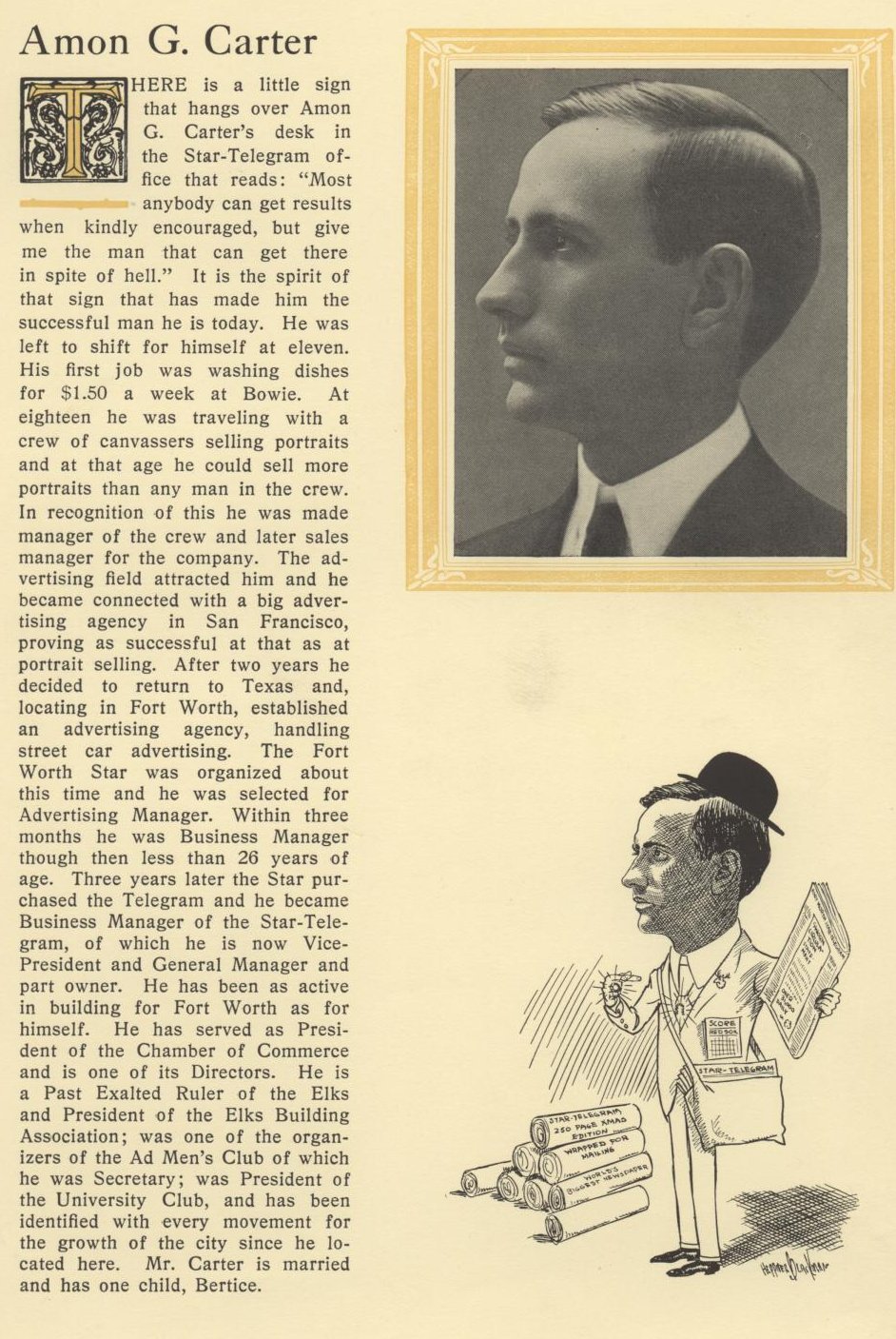 By then Carter had lived in Fort Worth seven years. It was home. He loved his state and his adopted hometown and had developed a sense of civic pride. Gradually, handshake by handshake, speech by speech, fund drive by fund drive, he became a civic leader and unabashed booster.
By then Carter had lived in Fort Worth seven years. It was home. He loved his state and his adopted hometown and had developed a sense of civic pride. Gradually, handshake by handshake, speech by speech, fund drive by fund drive, he became a civic leader and unabashed booster.
In 1914 the booklet Makers of Fort Worth listed Carter’s civic endeavors: president of the chamber of commerce, leader of the local Elks, secretary of the Ad Men’s Club, president of the University Club. “He has been as active building for Fort Worth as for himself . . . and has been identified with every movement for the growth of the city since he located here.”
And note his right hand in the sketch: He had gotten his diamond ring out of hock.
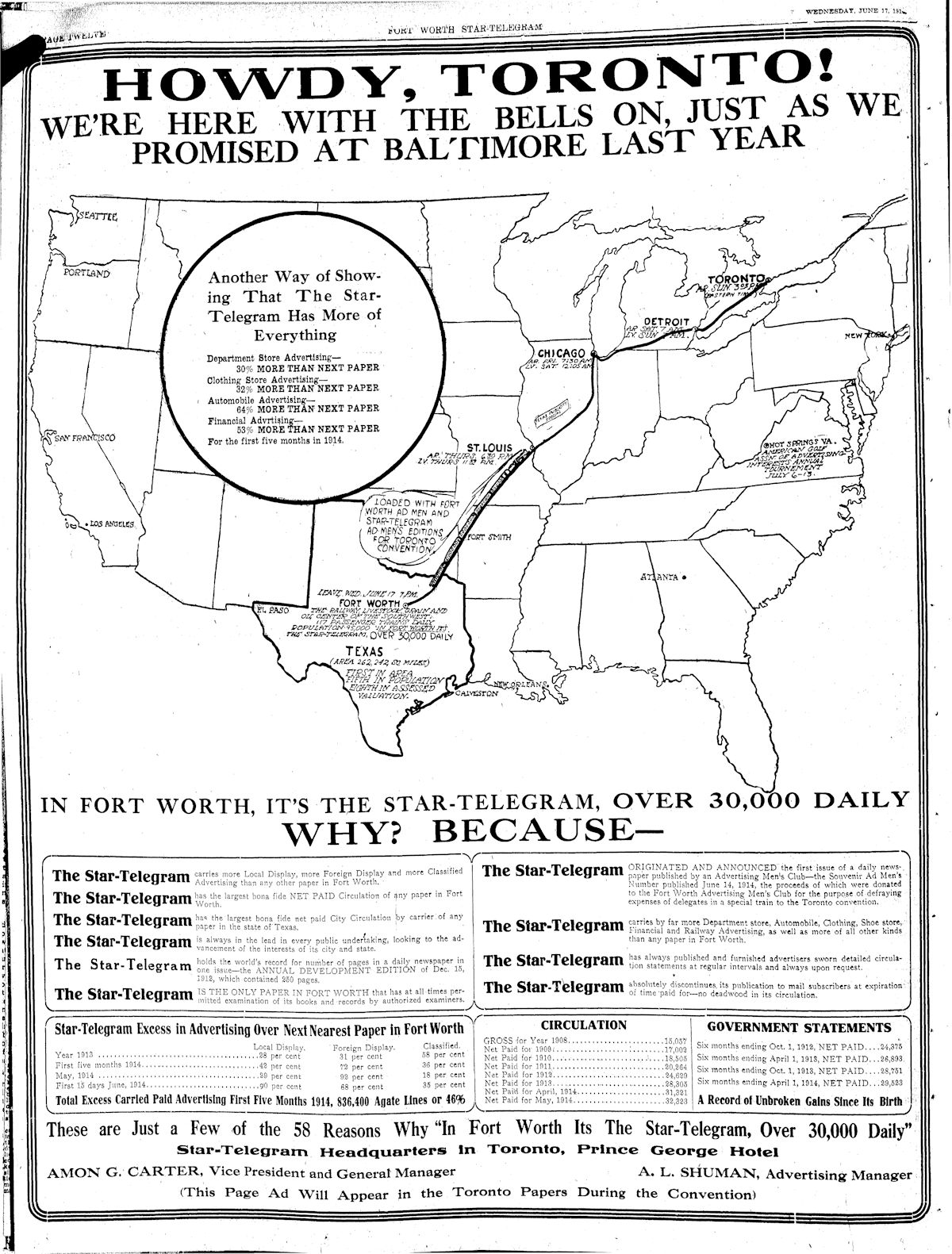 With an Amon-sized “Howdy,” in 1914 this full-page ad for the Star-Telegram, Fort Worth (“the railway, livestock, grain, and oil center of the Southwest”), and Texas (“first in area, fifth in population, eighth in assessed valuation”) appeared in both the Star-Telegram and newspapers in Toronto, which was hosting a convention of the Associated Advertising Clubs of the World.
With an Amon-sized “Howdy,” in 1914 this full-page ad for the Star-Telegram, Fort Worth (“the railway, livestock, grain, and oil center of the Southwest”), and Texas (“first in area, fifth in population, eighth in assessed valuation”) appeared in both the Star-Telegram and newspapers in Toronto, which was hosting a convention of the Associated Advertising Clubs of the World.
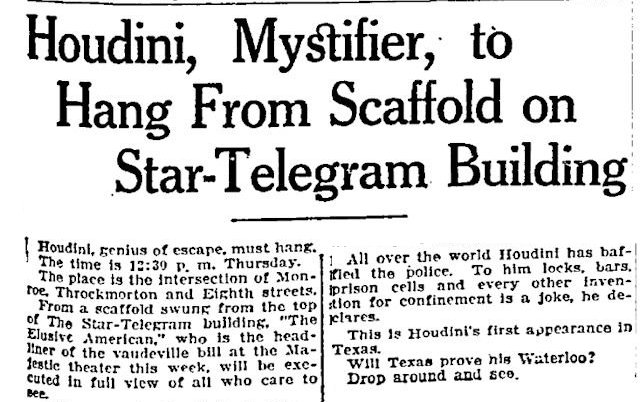 In 1916 “world-renowned self-liberator” Harry Houdini came to town to perform at the Majestic Theater. Carter and the Star-Telegram gave Houdini plenty of daily coverage but also devised a publicity campaign that made Houdini’s stay in town, as much as Amonly possible, all about the Star-Telegram.
In 1916 “world-renowned self-liberator” Harry Houdini came to town to perform at the Majestic Theater. Carter and the Star-Telegram gave Houdini plenty of daily coverage but also devised a publicity campaign that made Houdini’s stay in town, as much as Amonly possible, all about the Star-Telegram.
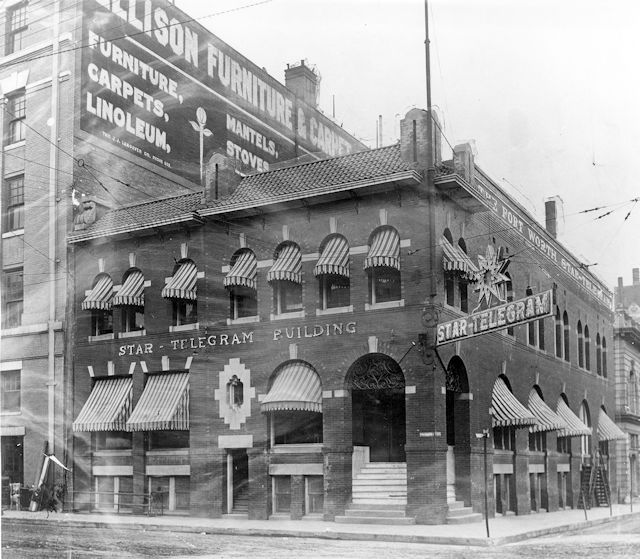
The Star-Telegram building on Throckmorton Street. (Photo from Jack White Photograph Collection, University of Texas at Arlington Libraries.)
 In 1917, soon after America went to war against Germany, Carter told people at a Red Cross fundraising rally, “We will simply show them that we won’t let anyone live here who won’t contribute to the Red Cross.”
In 1917, soon after America went to war against Germany, Carter told people at a Red Cross fundraising rally, “We will simply show them that we won’t let anyone live here who won’t contribute to the Red Cross.”
Amon Carter was not a man to take “no” for an answer. He once said, “‘No’ is just a word in the dictionary. I don’t often consult the dictionary.”
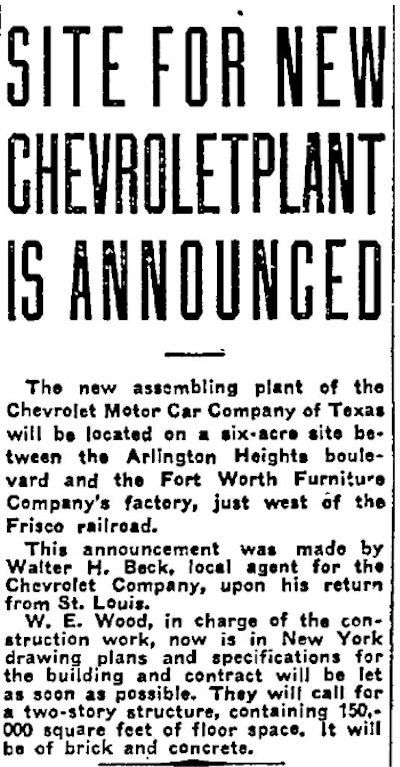 In 1916 Carter helped persuade the Chevrolet corporation to build a Chevy plant here.
In 1916 Carter helped persuade the Chevrolet corporation to build a Chevy plant here.
And in 1917 he promptly wrecked the first car off the assembly line. Amon was said to be a terrible driver. Flemmons writes that Carter drove the three miles from his home to the Star-Telegram office in second gear—and on any side of the road he found himself.
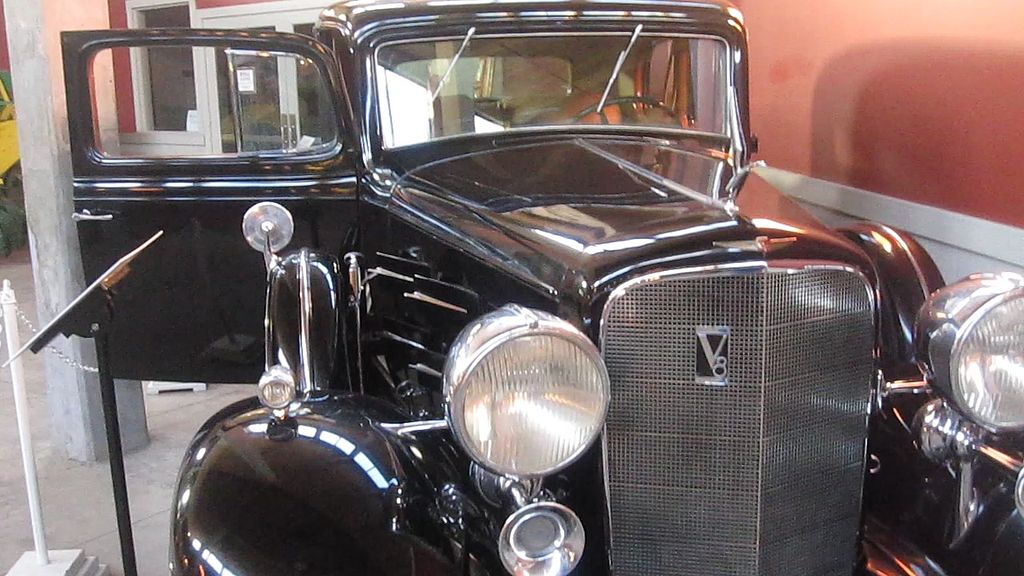 Amon Carter’s Cadillac is on display at the Texas Cowboy Hall of Fame at the stockyards.
Amon Carter’s Cadillac is on display at the Texas Cowboy Hall of Fame at the stockyards.
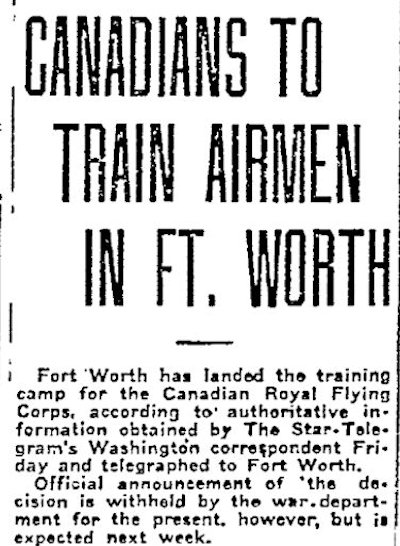 After America entered World War I Carter helped persuade the Army to locate its Camp Taliaferro in Fort Worth.
After America entered World War I Carter helped persuade the Army to locate its Camp Taliaferro in Fort Worth.
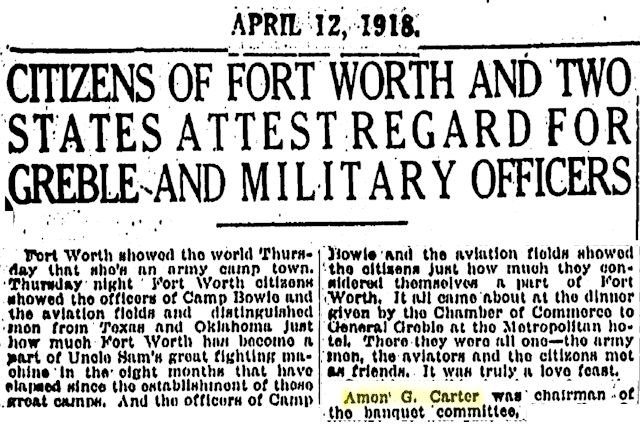 In 1918, when Fort Worth honored General Edwin St. John Greble, commander of Camp Bowie, Carter was chairman of the banquet committee.
In 1918, when Fort Worth honored General Edwin St. John Greble, commander of Camp Bowie, Carter was chairman of the banquet committee.
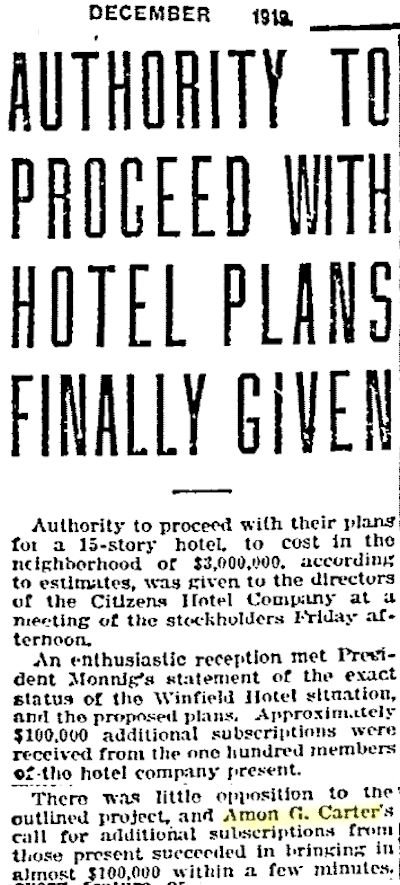 In 1919 Carter and other civic leaders decided that Fort Worth needed a world-class hotel. Carter was one of the investors and fundraisers of Citizens Hotel Company, which built the Hotel Texas. At a meeting of the company in 1919, he passed the hat and brought in $100,000 in subscriptions among those present.
In 1919 Carter and other civic leaders decided that Fort Worth needed a world-class hotel. Carter was one of the investors and fundraisers of Citizens Hotel Company, which built the Hotel Texas. At a meeting of the company in 1919, he passed the hat and brought in $100,000 in subscriptions among those present.
(E. P. Maddox, president of Crystal Ice Company, once advised, “Always do anything Amon asks you to do. Just give half as much money as he asks you for because he always asks for twice as much as he expects to get.”)
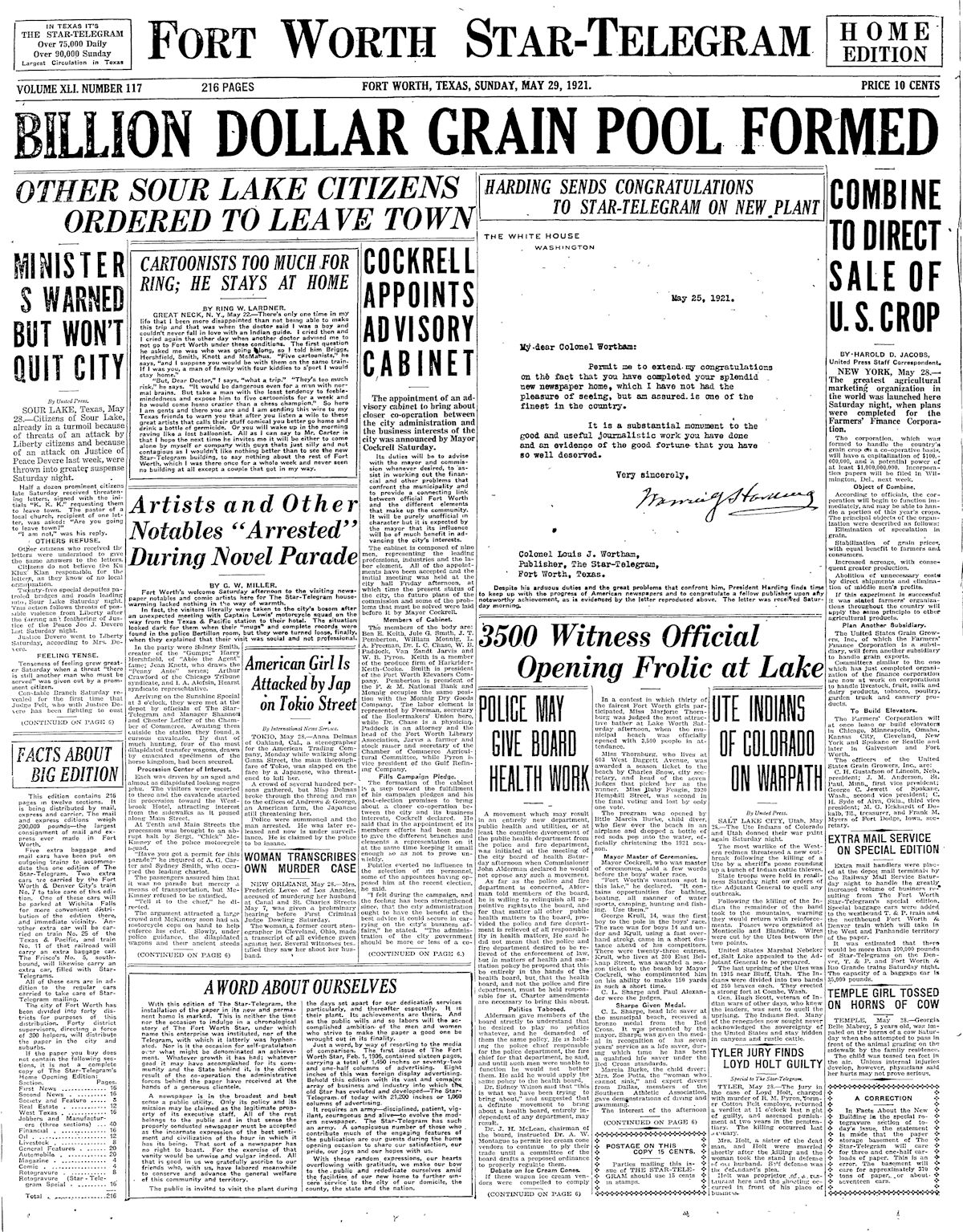 In 1921 Amon Carter and the Star-Telegram moved into their new “plant” (Sanguinet and Staats) on West 7th Street.
In 1921 Amon Carter and the Star-Telegram moved into their new “plant” (Sanguinet and Staats) on West 7th Street.
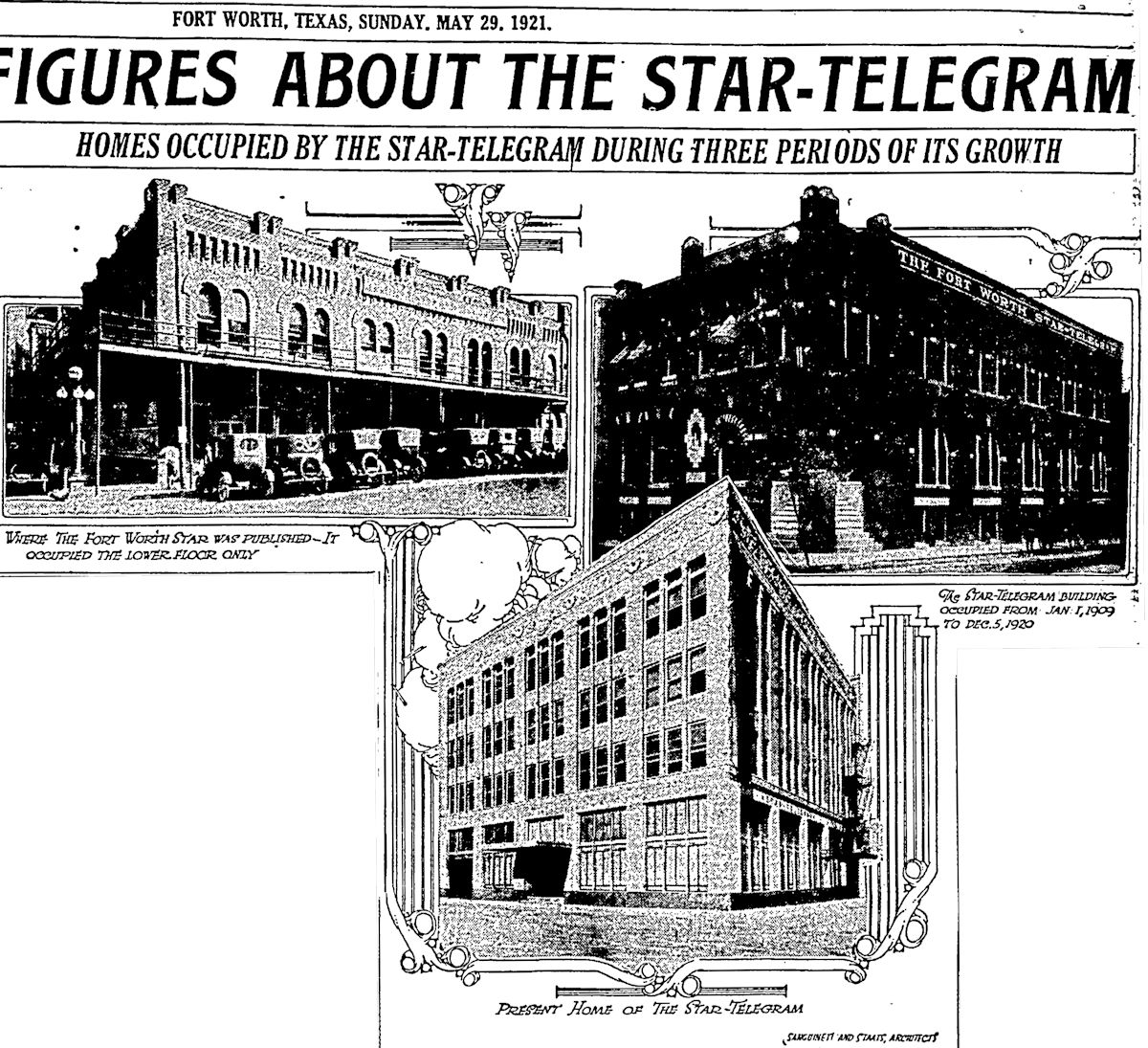 The newspaper published photos of the home of the Star (upper left) and the later homes of the Star-Telegram.
The newspaper published photos of the home of the Star (upper left) and the later homes of the Star-Telegram.
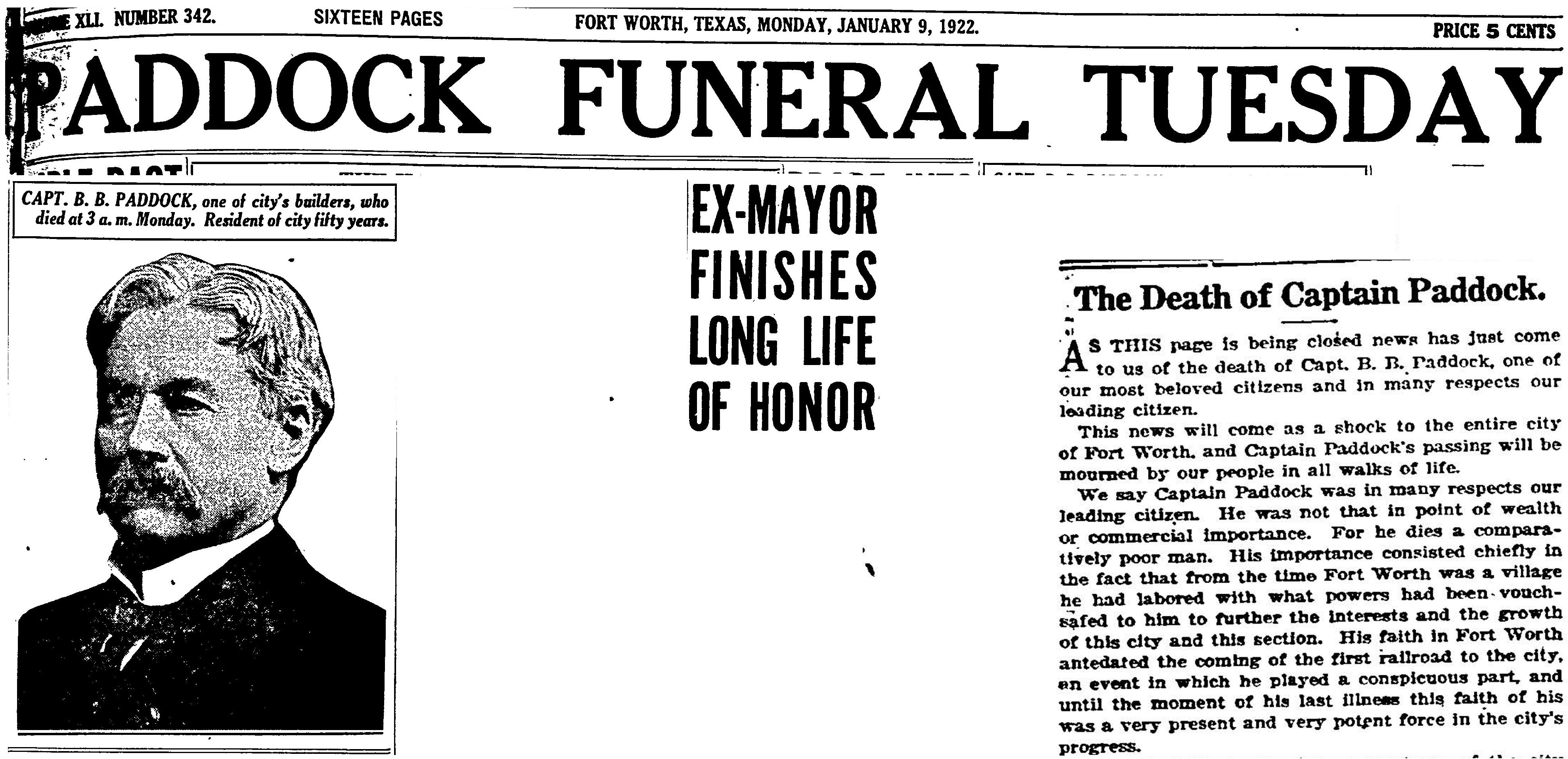 The next year, on January 9, 1922, Fort Worth lost the man who for a half-century had been the city’s biggest cheerleader before Amon Carter: B. B. Paddock.
The next year, on January 9, 1922, Fort Worth lost the man who for a half-century had been the city’s biggest cheerleader before Amon Carter: B. B. Paddock.
 On January 10 a symbolic transition took place as Paddock was buried: Among Paddock’s pallbearers was Amon Carter.
On January 10 a symbolic transition took place as Paddock was buried: Among Paddock’s pallbearers was Amon Carter.
The megaphone had been passed.
 Meanwhile, Carter had become smitten by the latest doodad: the radio transmitter. Ten weeks after Paddock died Carter and his Star-Telegram began promoting Fort Worth via a high-tech megaphone: Carter’s radio station WBAP officially began broadcasting on May 2.
Meanwhile, Carter had become smitten by the latest doodad: the radio transmitter. Ten weeks after Paddock died Carter and his Star-Telegram began promoting Fort Worth via a high-tech megaphone: Carter’s radio station WBAP officially began broadcasting on May 2.
 In 1923 the slogan “Where the West Begins” first appeared on the Star-Telegram nameplate.
In 1923 the slogan “Where the West Begins” first appeared on the Star-Telegram nameplate.
(Carter, like Paddock, relished Fort Worth’s rivalry with Dallas. Carter was quoted as saying “Fort Worth is where the West begins . . . and Dallas is where the East peters out.”)
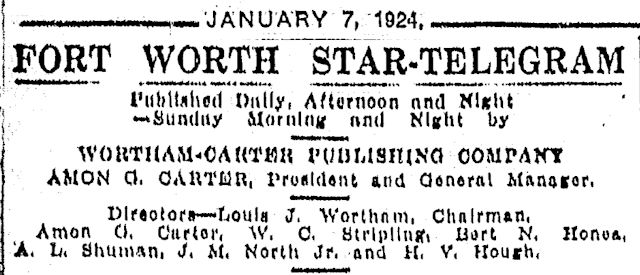 In 1924 Amon Carter, at age forty-five, became president and general manager of the Star-Telegram. By then he had assembled his dream team of businessmen and journalists who would guide the Star-Telegram through the middle of the twentieth century and who would remain on the newspaper’s masthead the rest of Carter’s life: Harold Hough, James North, Bert Honea.
In 1924 Amon Carter, at age forty-five, became president and general manager of the Star-Telegram. By then he had assembled his dream team of businessmen and journalists who would guide the Star-Telegram through the middle of the twentieth century and who would remain on the newspaper’s masthead the rest of Carter’s life: Harold Hough, James North, Bert Honea.
For the next thirty years the man who started out selling chicken sandwiches on trains would use, in private, his powers of persuasion and, in public, his newspaper and radio and television stations to sell Fort Worth and Texas to the world.






I would appreciate a copy of this article plus a copy of Part II. How may I acquire?
Thank you,
Janet Ansley
Janet, the easiest way is to download the post via your browser as a pdf file, which will be a mirror image of the post. For example, in Google Chrome, I start with the UPDATE button in the upper right. Choose PRINT, then DESTINATION and PDF.